- Home
- Susan Wittig Albert
The Darling Dahlias and the Cucumber Tree
The Darling Dahlias and the Cucumber Tree Read online
Table of Contents
Title Page
Copyright Page
Dedication
ONE - The Dahlias in Full Bloom
TWO - Ophelia
THREE - Verna
FOUR - Lizzy
FIVE - THE GARDEN GATE
SIX - The Dahlias Gather at Beulah’s Beauty Bower
SEVEN - Ophelia Lends a Helping Hand
EIGHT - Verna Tidwell, Amateur Sleuth
NINE - Lizzy Makes an Identification
TEN - The Dahlias Play Hearts
ELEVEN - Ophelia Learns Some Surprising Facts
TWELVE - Myra May Learns Some Startling Facts
THIRTEEN - Lizzy Learns Some Dismaying Facts
FOURTEEN - Verna and Lizzy: On the Case
FIFTEEN - Mr. Moseley Makes an Unexpected Proposition
SIXTEEN - Verna and Lizzy Have a Narrow Escape
SEVENTEEN - Myra May Organizes the Dahlias
EIGHTEEN - Lizzy and Verna Plan an Expedition
NINETEEN - Bessie Bloodworth Bags a Ghost
TWENTY - Ophelia Takes Bold Action and Lucy Takes Charge
TWENTY-ONE - Verna, Myra May, and Lizzy: On the Case in Monroeville
TWENTY-TWO - The Dahlias Clear up a Mystery or Two
TWENTY-THREE - Lizzy and Verna Hire a Lawyer
TWENTY-FOUR - The Dahlias Plant Their Sign
Makin’ Do: 12 Ways to Stretch Whatever We Have
The Dahlias’ Favorite Recipe
China Bayles Mysteries by Susan Wittig Albert
THYME OF DEATH
WITCHES’ BANE
HANGMAN’S ROOT
ROSEMARY REMEMBERED
RUEFUL DEATH
LOVE LIES BLEEDING
CHILE DEATH
LAVENDER LIES
MISTLETOE MAN
BLOODROOT
INDIGO DYING
A DILLY OF A DEATH
DEAD MAN’S BONES
BLEEDING HEARTS
SPANISH DAGGER
NIGHTSHADE
WORMWOOD
HOLLY BLUES
AN UNTHYMELY DEATH
CHINA BAYLES’ BOOK OF DAYS
With her husband, Bill Albert, writing as Robin Paige
DEATH AT BISHOP’S KEEP
DEATH AT GALLOWS GREEN
DEATH AT DAISY’S FOLLY
DEATH AT DEVIL’S BRIDGE
DEATH AT ROTTINGDEAN
DEATH AT WHITECHAPEL
DEATH AT EPSOM DOWNS
DEATH AT DARTMOOR
DEATH AT GLAMIS CASTLE
DEATH IN HYDE PARK
DEATH AT BLENHEIM PALACE
DEATH ON THE LIZARD
The Cottage Tales of Beatrix Potter by Susan Wittig Albert
THE TALE OF HILL TOP FARM
THE TALE OF HOLLY HOW
THE TALE OF CUCKOO BROW WOOD
THE TALE OF HAWTHORN HOUSE
THE TALE OF BRIAR BANK
THE TALE OF APPLEBECK ORCHARD
THE TALE OF OAT CAKE CRAG
The Darling Dahlias Mysteries by Susan Wittig Albert
THE DARLING DAHLIAS AND THE CUCUMBER TREE
Nonfiction books by Susan Wittig Albert
WRITING FROM LIFE
WORK OF HER OWN
THE BERKLEY PUBLISHING GROUP
Published by the Penguin Group
Penguin Group (USA) Inc.
375 Hudson Street, New York, New York 10014, USA
Penguin Group (Canada), 90 Eglinton Avenue East, Suite 700, Toronto, Ontario M4P 2Y3, Canada (a division of Pearson Penguin Canada Inc.)
Penguin Books Ltd., 80 Strand, London WC2R ORL, England
Penguin Group Ireland, 25 St. Stephen’s Green, Dublin 2, Ireland (a division of Penguin Books Ltd.) Penguin Group (Australia), 250 Camberwell Road, Camberwell, Victoria 3124, Australia
(a division of Pearson Australia Group Pty. Ltd.)
Penguin Books India Pvt. Ltd., 11 Community Centre, Panchsheel Park, New Delhi—110 017, India Penguin Group (NZ), 67 Apollo Drive, Rosedale, North Shore 0632, New Zealand
(a division of Pearson New Zealand Ltd.)
Penguin Books (South Africa) (Pty.) Ltd., 24 Sturdee Avenue, Rosebank, Johannesburg 2196, South Africa
Penguin Books Ltd., Registered Offices: 80 Strand, London WC2R ORL, England
This book is an original publication of The Berkley Publishing Group.
This is a work of fiction. Names, characters, places, andincidents either are the product of the author’s imagination or are used fictitiously, and any resemblance to actual persons, living or dead, business establishments, events, or locales is entirely coincidental. The publisher does not have any control over and does not assume any responsibility for author or third-party websites or their content.
PUBLISHER’S NOTE: The recipes contained in this book are to be followed exactly as written. The publisher is not responsible for your specific health or allergy needs that may require medical supervision. The publisher is not responsible for any adverse reaction to the recipes contained in this book.
Copyright © 2010 by Susan Wittig Albert.
All rights reserved.
No part of this book may be reproduced, scanned, or distributed in any printed or electronic form without permission. Please do not participate in or encourage piracy of copyrighted materials in violation of the author’s rights. Purchase only authorized editions.
BERKLEY® PRIME CRIME and the PRIME CRIME logo are trademarks of Penguin Group
(USA) Inc.
Library of Congress Cataloging-in-Publication Data
Albert, Susan Wittig.
p. cm.
eISBN : 978-1-101-18838-5
1. Young women—Crimes against—Fiction. 2. Murder-Investigation-Fiction.
3. Gardening—Societies, etc.—Fiction. 4. Women gardeners-Fiction. 5. Treasure troves—
Fiction. 6. Nineteen thirties—Fiction. 7. Alabama—Fiction. I. Title.
PS3551.L2637D37 2010
813’.54—dc22
2010010033
10987654321
http://us.penguingroup.com
To my cherished herb and gardening friends,
who encourage me to keep my hands in the dirt
and my fingers on the keyboard.
The Darling Dahlias and I send you our love.
Author’s Note
Darling, Alabama, is a fictional town that is located in a real place: the beautiful wooded hills of southern Alabama, about seventy miles north of Mobile, west of Monroeville, and east of the Alabama River. If you’d like a map of the town, please visit the series website: www.darlingdahlias.com. You’ll find other items of interest there, including: historical background of the 1930s, the period in which the series takes place; Depression-era recipes and household tips; and information about Southern gardens. I’ll be adding new material frequently, so please bookmark the site and visit often.
A note about the language. When I was growing up in the 1940s, we lived on the outskirts of the African-American neighborhood in Danville, Illinois. At the time, my family called our neighbors and schoolmates “coloreds” or “colored folk” or “Negroes.” Later, when I was in graduate school at University of California, Berkeley, and took an active part in the Civil Rights movement, we called our friends “Blacks” and “African Americans”; “Negro” had become an ethnic slur. (I notice, though, that the 2010 census uses “Negro” because many older African Americans self-identify with the term.) This historical series includes language and social practices appropriate to the early 1930s in the rural South. These may be offensive to some readers. Thank you for understanding that no offense is intended.
&n
bsp; Susan Wittig Albert
Dear Reader,
The author of this book has kindly asked us—the officers of the Darling Dahlias Garden Club—to write this letter to you. She wants us to let you know that we’ve read this story and agree with her description of what went on during the month of May 1930, when some things happened that shouldn’t have happened in any God-fearing town, much less in Darling, Alabama, which has 4 churches, 907 good Christian people (soon to be 908, because Mrs. Perkins is expecting any day now), and only a few Bad Apples.
Of course, in a story, it’s usually the Bad Apples who get all the attention, so we want to warn you not to pay too much attention to them. You should look instead at the way everybody else is behaving and doing what they ought to do, which is to help one another and follow the Golden Rule, even though (as a certain few would like to have you believe) it sometimes turns out that he who has the gold, rules. In this case, silver and gold, both, But we won’t say anything more about that, since we don’t want to spoil the story for you.
Anyway, we just wanted to let you know that we recommend this book because it’s true, most of it, And because the way the author has told it shows you how much the Dahlias care about our Darling and want to see things done right in our town, even when things are bad all over the country, with a lot of people out of work and the best help the Red Cross can offer is ten cents a day for food,
Well, that’s enough of that, The Darling Dahlias always try to look on the bright side. As Aunt Hetty Little says, we keep our face to the sun so we can’t see the shadows, which is why we plant sunflowers and marigolds and cosmos in amongst the collards and sweet potatoes and okra in the garden, And speaking of gardens and such, we may not have just a whole lot extra, but we’re always willing to share what we have. So we’ve given the author some of our favorite recipes and tips for making whatever you’ve got go further, last longer, and taste better. She says she’ll put them at the end of the book. We hope they’ll help you, if times are as hard at your house as they are here in Darling,
We hope you’ll keep looking on the bright side, too, And remember what we said about Bad Apples.
Elizabeth Lacy, president
Ophelia Snow, vice president & secretary
Verna Tidwell, treasurer
The Darling Dahlias Club Roister, May 1930
OFFICERS
Miss Elizabeth Lacy, president. Secretary to Mr. Moseley, attorney at law, and garden columnist for the Darling Dispatch.
Mrs. Ophelia Snow, vice president and secretary. Wife of Darling’s mayor, Jed Snow.
Verna Tidwell, treasurer. Secretary to the Cypress County probate clerk.
CLUB MEMBERS
Earlynne Biddle, married to Henry Biddle, the manager at the Coca-Cola bottling plant.
Mrs. Bessie Bloodworth, Darling’s historian. Owns Magnolia Manor, a boardinghouse next door to the Dahlias’ clubhouse and gardens.
Mrs. George E. Pickett Johnson, wife of the owner of the Darling Savings and Trust Bank. Specializes in pure white flowers.
Mildred Kilgore. A collector of camellias, Mildred is married to Roger Kilgore, the owner of Kilgore Motors, and lives near the Cypress Country Club.
Aunt Hetty Little, oldest member of the club, town matriarch, and lover of gladiolas.
Myra May Mosswell, owner of the Darling Diner and an operator in the Darling Telephone Exchange. Lives in the flat over the diner.
Miss Dorothy Rogers, Darling’s librarian. Miss Rogers knows the Latin name of every plant and insists that everybody else does, too. Lives in Magnolia Manor.
Beulah Trivette, artistically talented owner/operator of Beulah’s Beauty Bower, where small groups of Dahlias gather almost every day.
Alice Ann Walker, bank cashier. Her husband, Arnold, is disabled.
ONE
The Dahlias in Full Bloom
Sunday, May 11,1930
Elizabeth Lacy had been a member of the Darling Garden Club ever since Mrs. Blackstone started it in 1925, and president for the last two years. But she couldn’t remember a more important meeting. Today was a special day. They were celebrating the opening of their clubhouse.
Their new clubhouse, Lizzy thought proudly, as she called the meeting to order after their tour of the garden—although of course the house wasn’t new at all. It was the old Blackstone house at 302 Camellia Street, one block west of the courthouse square and one block south, next door to Bessie Bloodworth’s boardinghouse, Magnolia Manor. Mrs. Blackstone, a lifelong resident of Darling, had died a few months before at the grand age of eighty-two, leaving her house to the club, along with almost an acre of garden in the back, a half-acre vegetable garden in the adjoining lot, and two beautiful cucumber trees, one in front and one in back.
As usual, Lizzy started the meeting with the roll call. All twelve of their members were present on this special occasion. Since it was Sunday, the ladies were wearing their church outfits: summery flower-print cotton and crepe and rayon dresses with pretty collars of organdy and pique and dotted swiss and hats with ribbons and flowers. Their skirts were safely below their knees at last, now that the Roaring Twenties had stopped roaring. They were all very tired of the flapper look (especially since most of them had never been flappers) and ready for pleats and ruffles and those cute, perky angel bell sleeves that were (as Ophelia Snow put it) the very dickens to iron. Myra May was the only exception to the summer-dress rule. As usual, she wore trousers, light-colored, with a leather belt and tailored blouse.
After the roll call, Lizzy moved quickstep through Ophelia’s minutes (adopted, with a correction by Earlynne Biddle, who wanted it known that she had donated a book to the club library) and Verna Tidwell’s treasurer’s report (five dollars and fifty-two cents in the kitty). Bessie Bloodworth reported on the upcoming plant sale, which would be held the next Saturday at the Curbside Market on the courthouse square, and answered people’s questions about where to go and what to bring. She also invited people to volunteer for garden cleanup, which (as they could see from their tour) was going to be a big job. They would need all the help they could get.
Next, Lizzy took up the most important item of business, which was renaming their club in honor of their founder and benefactress, Mrs. Dahlia Blackstone. Henceforth and forever, they would be known as the Darling Dahlias, and their clubhouse would be called the Dahlia House. Ophelia Snow made the motion, Verna Tidwell seconded it, and there was a loud chorus of ayes.
“Which is good,” Lizzy said with satisfaction, “because Beulah has already painted our new sign. It’s leaning up against the tree for now, but we thought we’d have a little ceremony.” She reached for her Kodak. “Why don’t we go outside and I’ll take a picture for Friday’s column.”
For the last five years, Lizzy had written the “Garden Gate” column for the Darling Dispatch, which was edited and published by Charlie Dickens. The paper came out every Friday morning—unless there was a problem with the printing press, in which case it might be Saturday or even Monday, since Charlie would have to send down to Mobile for parts, and the parts would have to come back to Darling on the Greyhound bus. Lizzy loved writing the column, but she had a full-time job as secretary in Mr. Moseley’s law office and had to do it after hours, on the Underwood typewriter at work. She never ran out of things to put in her column, though. There was always something pretty in bloom or something interesting going on in somebody’s garden.
Outside, the club members gathered under the cucumber tree—so old and large and beautiful that it was one of the town’s landmarks—to witness the unveiling of the freshly painted wooden signboard. Myra May Mosswell did the honors. “Ta-ta-ta-TA-ta-ta!” she cried, imitating a trumpet, and pulled off the bedsheet that Lizzy had brought to drape over the sign. Beaming, she flung her arm around Beulah Trivette. “Didn’t Beulah do us proud, ladies? Just look at that beautiful basket of dahlias!”
Lizzy peered down into her Kodak, focused, and snapped. Beulah (whose talents as a hairdresser extended
to all things artistic) had really outdone herself this time. She had painted THE DARLING DAHLIAS in big fancy letters, in vivid green on a white background, arching the words over a basket of dahlias in every imaginable color: red, yellow, orange, peppermint-striped, purple. It was really too bad that the newspaper photo would be just plain old black-and-white, Lizzy thought. If people wanted to see the sign in full color, they’d have to walk over to Camellia Street for a look.
“It was nothing, really,” Beulah said in reply to Myra May. She tried not to look too pleased.
“Nothing?” Verna Tidwell chuckled. “Nothing short of gorgeous, Beulah. Beyond words.” A wordless murmur of assent rippled through the group.
But Voleen Johnson had words, as usual. “Tad bit gaudy for my taste,” she said, putting her head on one side. “Too many dahlias in that basket”
Lizzy sighed. When Voleen Johnson climbed onto her high horse, the best thing you could do was ignore her. “Okay, everybody,” she called. “I’ve got a good shot of Beulah and Myra and the sign. So if you’ll line up behind them, I’ll get the rest of you.”
Everybody dutifully lined up and put on their picture-taking faces. Lizzy looked through the camera, thinking that they were a fine group, in their spring dresses and perky straw hats—no more of those silly felt cloches that hugged your head and smashed your hair. They weren’t spring chickens, though, none of them. At thirty, Alice Ann Walker was the youngest. Aunt Hetty, nearly eighty, was the eldest, now that dear Mrs. Blackstone was gone. Next oldest was Mrs. Johnson, at fifty-five. The rest were clumped in the middle, give or take a few years.
“I believe I’ll just stand here,” Mrs. Johnson said, planting herself comfortably next to Myra May in the front row. She always put herself out front, and why not? She was the wife of George E. Pickett Johnson, owner of the Darling Savings and Trust Bank. What’s more, she was the spitting image of Mrs. Herbert Hoover, marcelled silver hair and all. Everybody thought so. Mrs. Johnson must’ve thought so, too, because she framed the cover of the May 13, 1929, issue of Time magazine, the one with Mrs. Hoover on it, with a string of real pearls wound around her throat and looped artistically down the front of her black dress. Lizzy knew this because Danzie, who did the Johnsons’ laundry on Mondays, was sister to Sally-Lou, who worked for Lizzy’s mother. Danzie had told Sally-Lou (and Sally-Lou had told Lizzy) that the First Lady was hanging right beside Mrs. Johnson’s dressing table.

 Hemlock
Hemlock Chile Death
Chile Death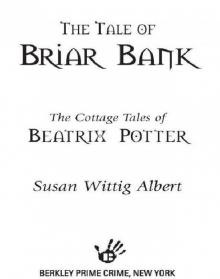 The Tale of Briar Bank
The Tale of Briar Bank Widow's Tears
Widow's Tears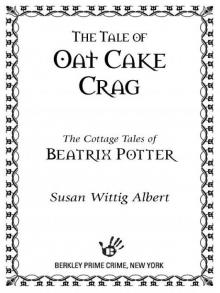 The Tale of Oat Cake Crag
The Tale of Oat Cake Crag Rueful Death
Rueful Death Bittersweet
Bittersweet The Darling Dahlias and the Poinsettia Puzzle
The Darling Dahlias and the Poinsettia Puzzle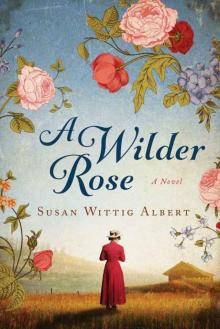 A Wilder Rose: A Novel
A Wilder Rose: A Novel Spanish Dagger
Spanish Dagger The Darling Dahlias and the Texas Star
The Darling Dahlias and the Texas Star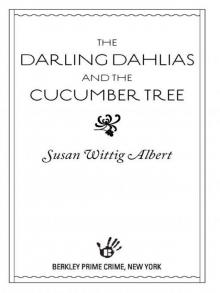 The Darling Dahlias and the Cucumber Tree
The Darling Dahlias and the Cucumber Tree China Bayles' Book of Days
China Bayles' Book of Days Death Come Quickly
Death Come Quickly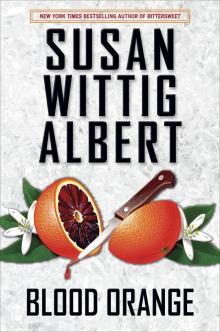 Blood Orange: A China Bayles Mystery
Blood Orange: A China Bayles Mystery Cat's Claw
Cat's Claw The Darling Dahlias and the Naked Ladies
The Darling Dahlias and the Naked Ladies The Tale of Hill Top Farm
The Tale of Hill Top Farm The Darling Dahlias and the Confederate Rose
The Darling Dahlias and the Confederate Rose The Darling Dahlias and the Silver Dollar Bush
The Darling Dahlias and the Silver Dollar Bush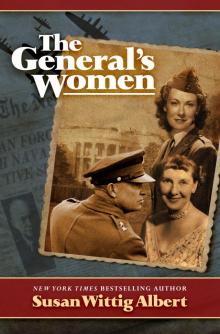 The General's Women
The General's Women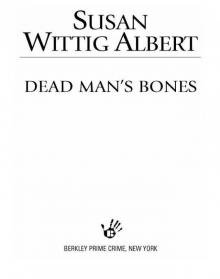 Dead Man's Bones
Dead Man's Bones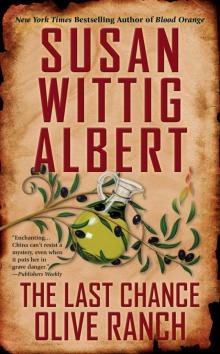 The Last Chance Olive Ranch
The Last Chance Olive Ranch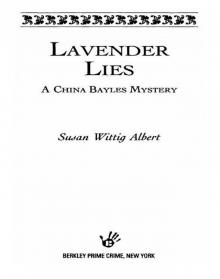 Lavender Lies
Lavender Lies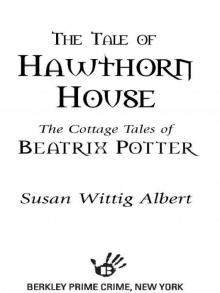 The Tale of Hawthorn House
The Tale of Hawthorn House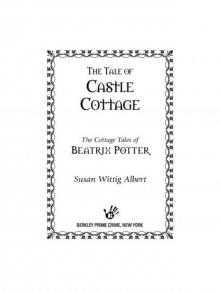 The Tale of Castle Cottage
The Tale of Castle Cottage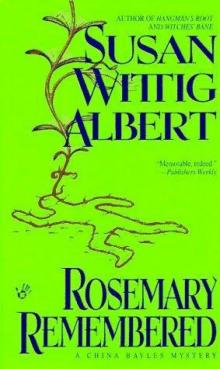 Rosemary Remembered - China Bayles 04
Rosemary Remembered - China Bayles 04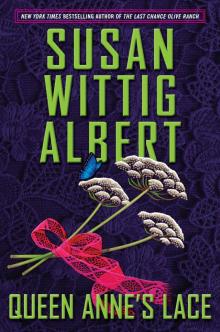 Queen Anne's Lace
Queen Anne's Lace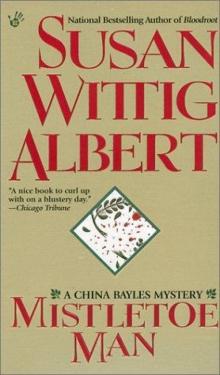 Mistletoe Man - China Bayles 09
Mistletoe Man - China Bayles 09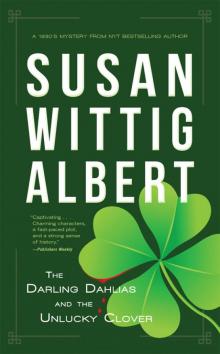 The Darling Dahlias and the Unlucky Clover
The Darling Dahlias and the Unlucky Clover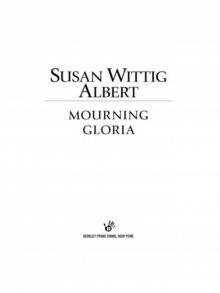 Mourning Gloria
Mourning Gloria The Darling Dahlias and the Eleven O'Clock Lady
The Darling Dahlias and the Eleven O'Clock Lady